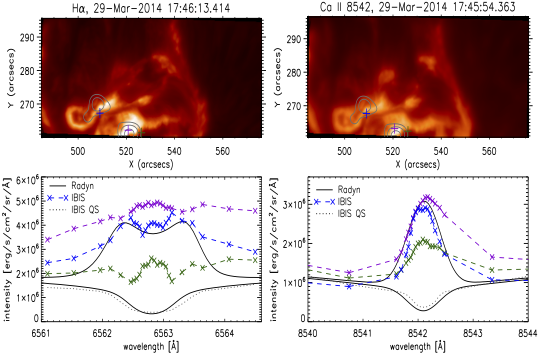Data-driven radiative hydrodynamic modeling of SOL2014-03-29
| Nugget | |
|---|---|
| Number: | 274 |
| 1st Author: | Fatima Rubio da Costa |
| 2nd Author: | |
| Published: | 10 May 2016 |
| Next Nugget: | Non-thermal recombination in solar flares and microflares |
| Previous Nugget: | Electron acceleration and hard X-ray emission from SOL2013-11-09 |
Introduction
A solar flare results from a sudden energy release involving magnetic reconnection in a domain containing free energy. A large fraction of the radiated energy originates in the chromosphere, so studying the chromospheric flare emission is therefore a key for understanding how the flare energy is transported and dissipated.
In this Nugget we describe the flare of March 29, 2014 17:45, SOL2014-03-29 (X1), from the point of view of the excellent chromospheric observations now becoming available both from ground-based data and new satellite data. Our ground-based data come from the Sacramento Peak Observatory in New Mexico, where the Dunn Solar Telescope makes observations with the IBIS imaging spectrometer, observing in this case H-alpha and the Ca II 8542 Å line. These lines,from singly-ionized ions, form at different heights and cover the whole chromosphere. They thus provide excellent diagnostics for the flare response of the lower solar atmosphere.
Estimation of the electron distribution
The analysis reported here [1] assumes the electron beam ("thick-target") model, wherein electrons accelerated in the corona precipitate into the lower atmosphere, heating it. We model the temporal evolution of the electron heating self-consistently from the integrated X-ray spectra obtained by RHESSI. The spectra were fitted to a thermal component plus a thick-target, non-thermal component. To estimate the electron flux, we divided the power of non-thermal electrons by the cross-sectional area of the footpoints in IRIS images (2796 Å). Figure 1 shows these parameters.

The RADYN radiative-hydrodynamics code [2,3] has done the hard work of following how the atmosphere responds to the energy deposited by the non-thermal electrons. We constructed a multi-threaded flare loop model and used the electron flux inferred from RHESSI as the input to the radiative hydrodynamic code RADYN to simulate the atmospheric response. The temporal evolution of the threads was estimated from the temporal derivative of the GOES 1-8 Å light curve, assuming that each spike corresponds to a single burst.
The chromospheric emissions
RADYN estimates the emission in H-alpha and Ca II 8542 Å; to study other lines, the atmospheric parameters resulting from RADYN go into a radiative-transfer model for other ions, such as our Mg II signatures. Comparing the model results to the observations, we find that the H-alpha and Ca II profiles fit the observed line shapes, while the Mg II IRIS profiles are broader in the wings than the synthetic ones. We find that the H-alpha and Ca II profiles fit the observed line shapes, while the Mg II IRIS profiles are broader in the wings than the synthetic ones. Figure 2 shows some of these profiles.

Conclusions
In general, the synthetic intensities agree with the observed ones. The simulated MgII h&k line profiles have narrower wings than the observed ones. This discrepancy can be reduced by using a higher microturbulence velocity (27 km/s) in a narrow chromospheric layer. An increase of electron density in the upper chromosphere within a narrow height range of 800 km below the transition region can turn the simulated MgII line core into emission and thus reproduce the single peaked profile, which is a common feature seen in all IRIS flares.
References
[1] "Data-driven Radiative Hydrodynamic Modeling of the 2014 March 29 X1.0 Solar Flare"
[2] "Does a nonmagnetic solar chromosphere exist?"
[3] "Radiative Hydrodynamic Models of the Optical and Ultraviolet Emission from Solar Flares"